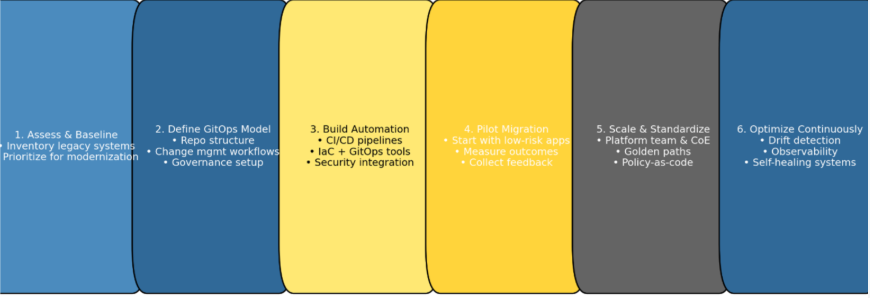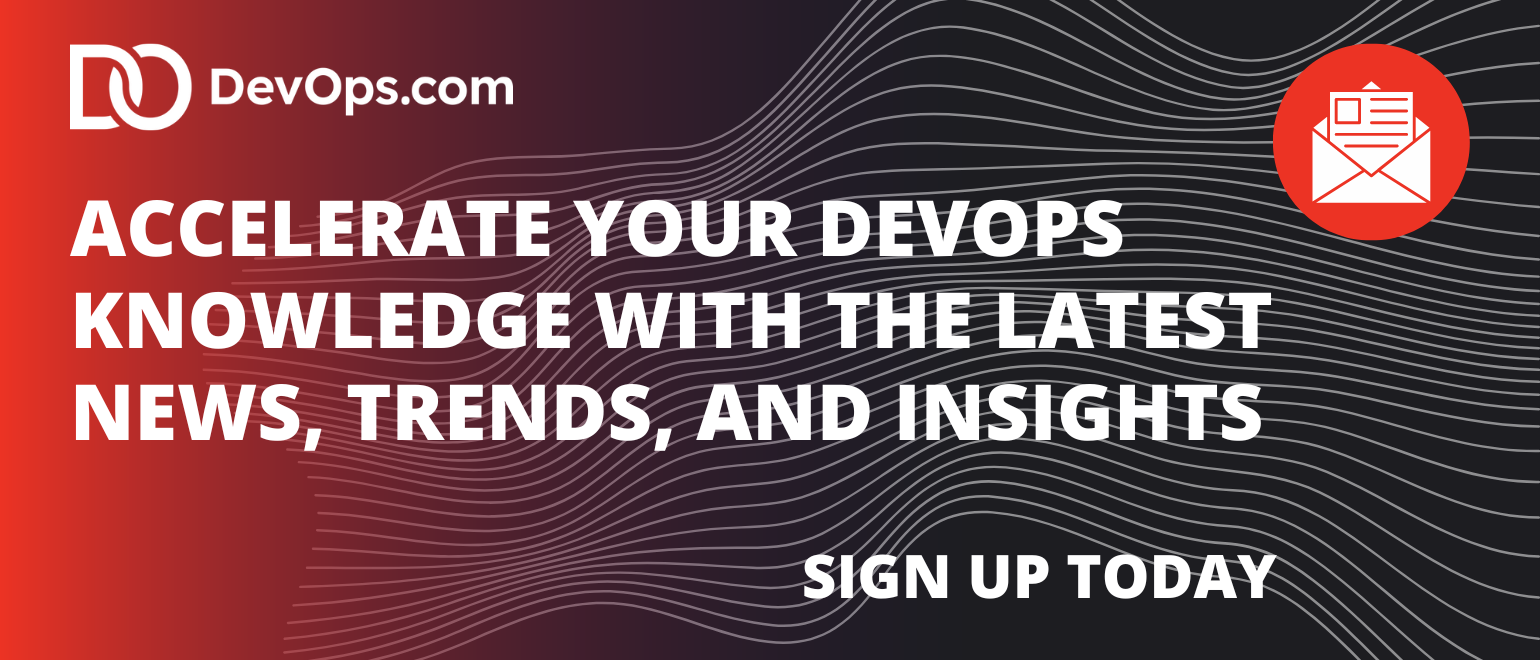In today’s highly dynamic digital landscape, organizations are turning to more cloud-native practices to realize agility, resiliency and ease of operation. One such groundbreaking methodology is GitOps, a cutting-edge model of infrastructure and application delivery management by means of version-controlled code repositories. While many startups have adopted GitOps from inception, large enterprises — often burdened with legacy systems — face unique challenges in making this shift.
This article outlines a complete roadmap to transition from conventional legacy infrastructure management to a GitOps-driven model, highlighting the strategic thoughts, architectural patterns, tooling selections and cultural shifts required to succeed at enterprise scale.
Understanding the Legacy Landscape
Before transitioning, it’s crucial to understand the nature and constraints of legacy systems within enterprises. Typically, these environments:
- Rely heavily on manual processes or ad hoc scripts.
- Operate in tightly coupled, monolithic architectures.
- Lack standardized CI/CD pipelines or use dated tools.
- Exhibit limited version control and weak auditability.
- Face regulatory and compliance burdens.
Such systems might span decades, running critical workloads on mainframes, bare metal, or outdated virtualization platforms. The challenge lies in balancing innovation with stability, modernizing without disrupting the business.
What is GitOps and Why Does it Matter
GitOps is an operational model where Git is the single source of truth for declarative infrastructure and application configurations. Changes are made via pull requests (PRs) and automatically applied to environments using agents (e.g., Argo CD, Flux) that sync the desired state from Git to the actual state in the runtime.
Key GitOps Principles:
- Declarative Infrastructure: Everything — from compute to networking—is defined as code.
- Versioned and Auditable: Git provides a complete history of changes and allows rollback.
- Automated Deployment: Changes in Git automatically trigger updates in environments.
- Continuous Reconciliation: GitOps agents constantly ensure the runtime matches the declared state.
In large enterprises, GitOps offers improved governance, security, speed and operational transparency, especially when coupled with Infrastructure-as-Code (IaC) and policy-as-code.
The Modernization Roadmap: Key Phases
Transitioning to GitOps is not a one-size-fits-all journey. It requires a strategic, phased approach, carefully balancing modernization with business continuity.

Enterprise GitOps Modernization Journey
Phase 1: Assess and Baseline the Current State
Begin with an enterprise-wide inventory of infrastructure assets, configurations, tools and processes.
Key Activities:
- Conduct workshops to identify critical legacy systems and dependencies.
- Classify systems by modernization readiness (e.g., cloud-ready, refactorable or retain-as-is).
- Evaluate current CI/CD pipelines and manual intervention points.
- Assess compliance, security and audit requirements.
Output:
- A modernization heatmap
- A prioritized backlog of systems for GitOps transformation
Phase 2: Define a GitOps Operating Model
Establish the foundational practices and guiding principles that will govern your GitOps implementation.
Considerations:
- Repo Strategy: Mono-repo vs. multi-repo for infrastructure and application code.
- Environment Promotion: Dev, staging, prod — each mapped to a Git branch or directory.
- Change Management: Align Git workflows (e.g., PR reviews, approvals) with internal controls.
- Separation of Duties: Define roles for developers, platform teams, and security engineers.
- Security Guardrails: Integrate policy-as-code tools like OPA/Gatekeeper for compliance.
Output:
- A GitOps governance blueprint
- Repository and branching standards
- Change approval workflows integrated with PRs
Phase 3: Build the Automation Backbone
Introduce modern CI/CD pipelines, IaC tools, and GitOps controllers that enable scalable and secure automation.
Tooling Options:
- Infrastructure-as-Code: Terraform, Pulumi, AWS CDK
- Configuration Management: Ansible, Helm, Kustomize
- GitOps Controllers: Argo CD, Flux
- CI/CD: GitHub Actions, GitLab CI, Jenkins, Tekton
Key Capabilities:
- Automated environment provisioning
- Git-triggered deployments and rollbacks
- Secret management via Vault, SealedSecrets, or SOPS
- Drift detection and reconciliation
Output:
- Standardized IaC modules and reusable templates
- GitOps pipelines integrated with security and testing gates
Phase 4: Incremental Migration and Piloting
Rather than a big-bang approach, start with pilot projects on non-critical systems or greenfield environments.
Migration Strategies:
- Lift-and-Shift + GitOps: Repackage existing VMs into cloud-native templates.
- Refactor into Microservices: Where feasible, break monoliths into containerized services.
- Hybrid Integration: Use GitOps to manage cloud-native workloads while retaining critical legacy systems in their current state, integrated via APIs or middleware.
Success Metrics:
- Reduction in manual interventions
- Shortened deployment lead times
- Improved change success rate
- Audit readiness and traceability
Phase 5: Expand, Standardize, and Harden
After successful pilots, scale GitOps across business units and standardize practices for global operations.
Enterprise Scaling Patterns:
- Create a platform engineering team to manage shared services and reusable modules.
- Develop golden paths — predefined workflows and templates for developers.
- Enforce policy-as-code for security, tagging, naming conventions and cost controls.
- Integrate with ITSM (e.g., ServiceNow) for enterprise-wide visibility and incident tracking.
Organizational Considerations:
- Define Centers of Excellence (CoEs) for GitOps knowledge sharing.
- Establish training programs and internal certifications.
- Align platform investments with OKRs and executive sponsorship.
Phase 6: Continuous Optimization and Observability
GitOps isn’t a destination — it’s a continuous journey. Mature organizations evolve toward self-healing, autonomous systems.
Best Practices:
- Use canary or blue-green deployments to reduce risk.
- Integrate with observability platforms (Prometheus, Grafana, Datadog) for monitoring GitOps health.
- Implement drift detection to catch and reconcile out-of-band changes.
- Conduct postmortems and improve runbooks based on production incidents.
Challenges and How to Overcome Them
- Tooling Sprawl: Avoid adopting too many overlapping tools. Instead, define a clear ecosystem with vetted tools and plugins, aligned with enterprise standards.
- Cultural Resistance: Introduce GitOps through champions and showcase success stories. Tie benefits to business goals: faster releases, better uptime, and auditability.
- Legacy Constraints: Not all systems need to be modernized. For deeply entrenched legacy workloads, consider encapsulating them behind APIs while applying GitOps to the surrounding ecosystem.
- Security Concerns: Collaborate with InfoSec teams early. Use Git-based access control, encrypted secrets, and policy-as-code to satisfy security requirements.
GitOps at Scale: A Glimpse into the Future
For enterprises that succeed in GitOps transformation, the long-term benefits are significant:
- Unified Governance: One Git repo becomes the source of truth across teams.
- Developer Velocity: Engineers can deploy infrastructure as easily as code.
- Resilience by Design: Reconciliation and automation reduce downtime.
- Audit-Readiness: Every change is tracked, approved, and recoverable.
- Compliance Simplification: Git history supports SOX, PCI, ISO audits effortlessly.
As infrastructure becomes increasingly dynamic—with edge computing, AI workloads, and multi-cloud environments — GitOps offers a scalable, composable, and secure model to keep pace with digital acceleration.
Final Thoughts
Moving from legacy systems to GitOps is more than a technical overhaul—it’s a cultural and operational evolution. Enterprises must balance innovation with stability, agility with governance, and speed with security. By following a phased roadmap — starting with assessment, moving through implementation and scaling — organizations can reap the rewards of GitOps while managing risk.
Modernizing legacy infrastructure is never easy, but with GitOps, enterprises finally have a blueprint for automation, transparency, and resilience at scale.




